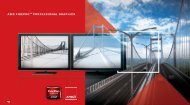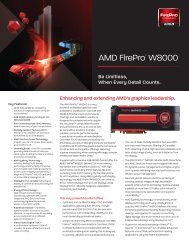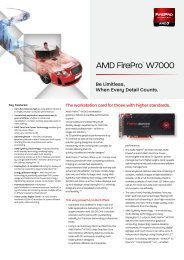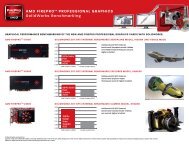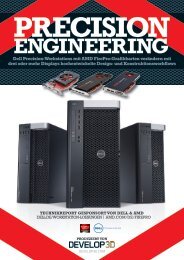Dell - AMD FirePro
Dell - AMD FirePro
Dell - AMD FirePro
You also want an ePaper? Increase the reach of your titles
YUMPU automatically turns print PDFs into web optimized ePapers that Google loves.
Image courtesy of SolidWorks<br />
Image courtesy of jreis and Luxion WORKSTATIONS<br />
Computer Aided<br />
Engineering (CAE) or<br />
simulation software<br />
includes a wide range of tools<br />
to help engineers predict the<br />
performance of products.<br />
Primary software comprises<br />
Finite Element Analysis<br />
(FEA) for stress analysis,<br />
Computational Fluid Dynamics<br />
(CFD) for thermal and fluid<br />
flow analysis, and kinematics.<br />
Key software developers<br />
include Ansys, Autodesk, DS<br />
dell.co.uk/workstation fireprographics.com TECHNICAL REPORT<br />
FOR CAE<br />
Design visualisation<br />
software is used to<br />
create photorealistic<br />
renderings or animations of<br />
designs. To achieve this, the<br />
majority of applications use<br />
‘ray tracing’, a computationally<br />
intensive technique that traces<br />
paths of light and simulates<br />
how they interact with virtual<br />
objects. Key software includes<br />
Autodesk 3ds Max Design,<br />
Bunkspeed Shot, Luxion<br />
Keyshot, Luxology Modo,<br />
Simulia, CD-adapco, MSC<br />
Software, PTC and Siemens.<br />
Workstation<br />
The compact dual processor<br />
<strong>Dell</strong> Precision T5600 is well<br />
suited to CAE. For ultimate<br />
performance, with enough<br />
memory to handle the biggest<br />
datasets, the T7600 is a better fit.<br />
Processor (CPU)<br />
Most CAE software is multithreaded.<br />
i.e. simulations can be<br />
Maxon Cinema 4D, NewTek<br />
LightWave and RTT DeltaGen.<br />
Most CAD software also<br />
includes built-in photorealistic<br />
rendering technology.<br />
Workstation<br />
A dual processor workstation,<br />
such as the compact <strong>Dell</strong><br />
Precision T5600 is well suited to<br />
entry-level design visualisation.<br />
For ultimate performance the<br />
T7600 is a good match, with<br />
expanded options for memory<br />
solved quicker with multi-core<br />
processors. However, a lot of<br />
CAE software offers diminishing<br />
returns above two or three CPU<br />
cores, with a cluster needed to<br />
truly accelerate solve times. Dual<br />
processor workstations can offer<br />
improved performance though<br />
and also the ability to multi<br />
task. For example, an engineer<br />
can run multiple ‘what-if’<br />
simulations concurrently to help<br />
find more optimal solutions.<br />
Graphics card (GPUs)<br />
Graphics requirements vary<br />
from application to application.<br />
A mid-range card, like the<br />
<strong>FirePro</strong> W5000, will be a good<br />
fit for a lot of CAE software, but<br />
some applications, including<br />
CEI Ensight and MSC Patran,<br />
can make use of more highend<br />
cards such as the <strong>FirePro</strong><br />
W7000 or W8000. <strong>AMD</strong><br />
Eyefinity technology can run<br />
three or more displays from a<br />
and high-performance RAID<br />
hard drive setups.<br />
Processor (CPU)<br />
All rendering software is multithreaded<br />
and can be accelerated<br />
by multiple CPU cores. In fact,<br />
as a rule of thumb, doubling<br />
the number of CPU cores<br />
halves the rendering time. This<br />
makes a dual processor system,<br />
with eight cores per CPU,<br />
an excellent choice for those<br />
looking to seriously accelerate<br />
render times.<br />
Graphics card (GPU)<br />
Most design visualisation<br />
software can make good use of<br />
high-end graphics, making the<br />
<strong>AMD</strong> <strong>FirePro</strong> W7000 or <strong>AMD</strong><br />
<strong>FirePro</strong> W8000 good options.<br />
Graphics memory is also<br />
important so large textures can<br />
be loaded. Here, 2GB or 4GB is<br />
a good amount.<br />
<strong>AMD</strong> Eyefinity technology, at<br />
single card. This can lead to big<br />
productivity benefits as new jobs<br />
can be prepared while others are<br />
monitored. Results can also be<br />
compared side by side.<br />
The rise of the OpenCL<br />
compute language also<br />
means GPUs can now be used<br />
alongside CPUs to reduce the<br />
solve times of simulations. The<br />
OpenCL-compliant version of<br />
Abaqus from DS Simulia, for<br />
example, can take advantage<br />
of GPUs for structural and<br />
multiphysics analysis.<br />
The <strong>AMD</strong> <strong>FirePro</strong> W8000 is<br />
particularly suited to CAE due<br />
to its high rating for doubleprecision<br />
performace.<br />
Memory (RAM)<br />
Simulations can take up lots of<br />
memory, so 16GB of ECC RAM<br />
is common, with anything up to<br />
192GB for extremely complex<br />
problems. A 64-bit Operating<br />
System is essential.<br />
WORKSTATIONS FOR vIz<br />
the heart of the <strong>FirePro</strong> W-Series,<br />
means up to four displays can<br />
be powered by a single graphics<br />
card. This can be used to boost<br />
productivity in design viz<br />
workflows. For example, the<br />
digital artist can use the centre<br />
display for scene preparation,<br />
with two flanking displays<br />
used for CAD modelling or to<br />
host toolbars, texture libraries,<br />
or test renders. Alternatively,<br />
a single high-resolution 2 x 2<br />
array powerwall can be made up<br />
of four individual displays for<br />
stunning presentations.<br />
Memory (RAM)<br />
Design visualisation software<br />
can use up a lot of memory with<br />
geometry and texture maps both<br />
contributing to the load. 16GB<br />
of ECC memory is typical, with<br />
much more needed for complex<br />
datasets. A 64-bit Operating<br />
System, such as Microsoft<br />
Windows 7 64-Bit, is essential.<br />
7




